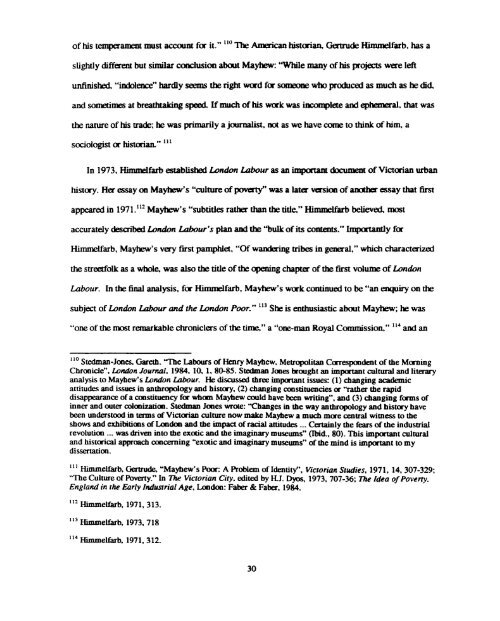You also want an ePaper? Increase the reach of your titles
YUMPU automatically turns print PDFs into web optimized ePapers that Google loves.
of his teaperameat must account fa it." 'lo Tk American histaim. Gatrude Himmelfub, has a<br />
slightly different but similar coac1usion a ht Maw: "While many of his projects were left<br />
unfinished, "indolence*' hardly seems the right wmd for someone who produced as much as be did<br />
and sometimes at breathtaking speed If much of his wcxk was incomplete and ephemeral, that was<br />
the nature of his trade; he was primarily a journalist, not as we have come to think of him, a<br />
sociologist a histaian" " '<br />
In 1973, Himmelfarb established b nhn Labour as an iqa%mt document of Victorian urban<br />
histay. )Iar essay on Mayhew's "cuiture of pmertf was a law d m of andher essay that first<br />
appeared in 1971. 'I2<br />
Maykw's "subtitles r aw than the title*" Himmelfarb believed most<br />
accurately described London Labour's pian and the "bulk of its conterrts." Importantly fa<br />
Himmelfarb, Mayfiew's very first pamphlet, "Of wandaing tribes in general," which charactaized<br />
the streetfolk as a whole, was also the title of the opening chapter of the first volume of London<br />
Labour. In the final analysis, fa Himmelfarb, Mayhew's wcrk continued to be "an enquiry on tk<br />
subject of London Lubour md the London Pwr." 'I3 She is enthusiastic about Mayhew; he was<br />
"one of the m st remarkable chroniclers of the time," a "one-man Royal Commission," 'I4<br />
and an<br />
'I0 Stedman-Jones, Gareth. The Labours of Henry Mayhew. Metropolitan Correspmdent of the Morning<br />
Chronicle*', London Journal, 1984, 10, 1. 80-85. S tedman Jmes brought an importaat cultural and literary<br />
analysis to Mayhew's &don Luhur. He discussed three important issues: (1) changing academic<br />
attitudes and issues in anthropology and history, (2) changing coastituencies or "rather the rapid<br />
disappearance of a coostituency fa wharn Mayhew could have been writing", and (3) changing fams of<br />
inner and outer mloaization. S tedman Jones wrote: "Changes in the way anthropology and history have<br />
been understood in terms of Victorian culture now make Mayhew a much more central wimess to the<br />
shows and exhibitims of -don and the impact of racial attitudes ... Certainly the fears of the industrial<br />
revolu tioa .. . was driven into the exotic and be imaginary museums" (Ibid, 80). This impatan t cultural<br />
and historical approach concerning "'exotic and imaginary museums" of the mind is impatant to my<br />
dissertation.<br />
" ' Himmebb, Gertrude, nMayhew's Pm: A Roblem of Identity", Victorian Srdics. 1971, 14,307-329:<br />
"The Culture of Poverty." In Tire Victorian City, edited by HJ. Dp, 1973, 707-36; Tlre Idea of Poveny.<br />
England in the Early Indus1rial Age, Loadon: F ak & Faber, 1984.<br />
Himmelfarb, 1971, 313.<br />
"3 Himmelfarb, 1973, 718
















